Application of Improved PNN in Transformer Fault Diagnosis
Abstract
1. Introduction
2. Transformer Fault Types and Existing Diagnosis Methods
2.1. Classification of Transformer Fault Types
- (1)
- Abnormal sound: When the transformer is in normal operation, the transformer keeps silent or emits regular noise. With a sudden increase in the load carried by the transformer, looseness of internal parts or aging of insulation performance will cause the transformer to emit noise. This kind of fault generally occurs in summer, especially when the high-temperature power load is heavy.
- (2)
- Abnormal oil temperature: The mineral oil inside the transformer not only plays the role of insulation protection but also plays the role of cooling. The reason for the high temperature of transformer mineral oil is generally either the insulation of the internal threading screw is damaged or the short circuit of the internal winding of the transformer generates a short circuit current much higher than the rated operating state, and generates a lot of heat, resulting in the abnormal temperature of the internal insulation oil of the transformer [18].
- (3)
- Abnormal height and color of mineral oil inside the transformer: When the transformer is operating under high temperatures and heavy load in summer, the temperature inside the transformer is high, which makes black particles such as black carbon appear in the oil, thus causing the color of insulating oil to be too heavy. In addition, when the sealing property of the transformer decreases, the leakage and volatilization of the transformer will occur, resulting in an abnormal oil level. If the internal insulating oil of the transformer is lower than the minimum mark, manual refueling is required to maintain the thermal insulation requirements of the transformer during normal operation [19].
- (4)
- Unbalanced three-phase load: When the load carried by the transformer is three-phase unbalanced, the three-phase current is often asymmetric, which leads to unbalanced three-phase voltage. It should be pointed out that when ferromagnetic resonance and turn-to-turn short circuits occur in the power system, an unbalanced three-phase load fault state will also occur [20].
- (5)
- Lead part fault: Common faults of the lead part include poor contact caused by loose wiring, lead burnout caused by overcurrent, etc. In the case of such faults, it is necessary to handle the faults and cut off the power supply as soon as possible to avoid further expansion of the fault scope.
2.2. Analysis of Deficiencies in Existing Diagnostic Methods
- (1)
- Limitations of high-precision calculation: The accuracy of the traditional three-ratio method and Dornerburg method, derived from the dissolved gas analysis method, is not high, and the diagnosis is based on a single method, which cannot fully reflect the complex mapping relationship between transformer fault causes and fault types. Due to the differences in transformer capacity, voltage level, operation history, manufacturer and system environment, the accuracy of transformer fault diagnosis can only reach about 80%. In addition, traditional methods such as the three-ratio method can be used to analyze the nature of the fault only when the content of each component of the gas in the oil is high enough (generally, it means that it exceeds the set critical value). Therefore, if the three-ratio method is used to judge the real-time status monitoring of the transformer, it will often lead to misjudgment and unnecessary economic losses.
- (2)
- Limitations of online calculation: Traditional methods have high requirements for external environmental conditions when conducting gas composition analysis, requiring skilled operators to conduct on-site operations, which costs a lot of time and generally takes more than 3 h. On the other hand, it cannot be ignored that the longer the time spent, the change in the gas composition may be caused by the sampling and storage process of dissolved gas in the transformer, which will eventually lead to a deviation in the accuracy of the calculation results and cannot meet the requirements of online monitoring. When the internal faults in transformers develop rapidly, it is difficult for relevant operators and maintenance personnel to quickly obtain the internal dynamic information from transformers, thus causing huge economic losses.
- (3)
- Limitations of human cost investment: Traditional methods rely on skilled operators for analysis and calculation. With the growing scale of the power grid, the number of transformers increases sharply, the corresponding types and voltage levels of transformers are different and the amount of transformer status data fed back is large, which greatly increases the difficulty in fault diagnosis and analysis by staff. In the case of time constraints and numerous data dimensions, due to subjective factors such as fatigue operation, data entry and calculation errors inevitably occur.
3. Model and Application of Improved PNN
3.1. Introduction of PNN
3.2. Introduction of PSO Algorithm
3.3. Solution Process of Improved PNN
4. Results
4.1. Fault Diagnosis Results Analysis of the Proposed Method
4.2. Comparison with Other Methods
5. Conclusions
Author Contributions
Funding
Conflicts of Interest
References
- Mohsen, F.; Abouzar, S.; Abolfazl, S. Reliability evaluation of a composite power system in the presence of renewable generations. Reliab. Eng. Syst. Saf. 2022, 222, 108396. [Google Scholar]
- Mahdavi, M.; Javadi, M.S.; Catalão, J.P.S. Integrated generation-transmission expansion planning considering power system reliability and optimal maintenance activities. Int. J. Electr. Power Energy Syst. 2023, 145, 108688. [Google Scholar] [CrossRef]
- Shen, Y.; Rong, X.; Ma, J.; Zhou, J.; Zhang, H.; Yang, H. A reliability review on electrical collection system of battery energy storage power station. Energy Rep. 2021, 7, 1336–1343. [Google Scholar] [CrossRef]
- Rachna, V.U.D.; Saurabh Tewari, S.M.T. Machine learning applications in power system fault diagnosis: Research advancements and perspectives. Eng. Appl. Artif. Intell. 2021, 106, 104504. [Google Scholar]
- Akshay, A.; You, F. Quantum computing based hybrid deep learning for fault diagnosis in electrical power systems. Appl. Energy 2021, 303, 117628. [Google Scholar]
- Liu, S.; Sun, Y.; Zhang, L.; Su, P. Fault diagnosis of shipboard medium-voltage DC power system based on machine learning. Int. J. Electr. Power Energy Syst. 2021, 124, 106399. [Google Scholar] [CrossRef]
- Soufiane, B.; Noureddine, B.; Azzeddine, B.; Bousaadia, B.; Karim, A. Deep learning through LSTM classification and regression for transmission line fault detection, diagnosis and location in large-scale multi-machine power systems. Measurement 2021, 177, 109330. [Google Scholar]
- Wang, S.; Zhao, D.; Yuan, J.; Li, H.; Gao, Y. Application of NSGA-II Algorithm for fault diagnosis in power system. Electr. Power Syst. Res. 2019, 175, 105893. [Google Scholar] [CrossRef]
- Dong, M.; Meng, Y.; Xu, C. Research on fault diagnosis model of large power transformer based on support vector machine and dissolved gas analysis. J. Chin. Electr. Eng. Sci. 2003, 14, 88–102. [Google Scholar]
- Mo, J.; Wang, X.; Dong, M. Power transformer fault diagnosis method based on rough set theory. J. Chin. Electr. Eng. Sci. 2004, 12, 166–175. [Google Scholar]
- Medeiros, R.P.; Costa, F.B. A wavelet-based transformer differential protection with differential current transformer saturation and cross-country fault detection. IEEE Trans. Power Deliv. 2017, 17, 11–27. [Google Scholar] [CrossRef]
- Kim, J.W.; Park, B.K.; Jeong, S.C. Fault diagnosis of a power transformer using an improved frequency-response analysis. IEEE Trans. Power Deliv. 2005, 20, 169–178. [Google Scholar] [CrossRef]
- Xie, K.; Luo, A. Application of Genetic Algorithm in Transformer Fault Diagnosis. Electr. Power Autom. Equip. 2005, 25, 55–68. [Google Scholar]
- Dawood, K.; Çınar, M.A.; Alboyacı, B. Diagnosis of axial displacement in transformer windings using finite element analysis. J. Math. Sci. Model. 2018, 1, 27–32. [Google Scholar] [CrossRef]
- Moradnouri, A.; Vakilian, M.; Hekmati, A.; Fardmanesh, M. HTS Transformer’s Partial Discharges Raised by Floating Particles and Nitrogen Bubbles. J. Supercond. Nov. Magn. 2020, 33, 3027–3034. [Google Scholar] [CrossRef]
- Moradnouri, A.; Vakilian, M.; Hekmati, A.; Fardmanesh, M. The end part of cryogenic H. V. bushing insulation design in a 230/20 kV HTS transformer. Cryogenics 2020, 108, 103090. [Google Scholar] [CrossRef]
- Ji, L.; Bao, L.; Li, K.; Huang, Y.; Zhang, P. Research on Fault Identification Method of Dry-type Transformers Based on Support Vector Machine. In Proceedings of the 22nd International Conference on Electrical Machines and Systems (ICEMS), Harbin, China, 11–14 August 2019; pp. 1–6. [Google Scholar]
- Yu, T.; Wang, H.; Chen, X.; Tan, K. Fault Diagnosis and Fault Tolerant Method of Single Stage Matrix Type Power Electronic Transformer. In Proceedings of the 2021 IEEE 1st International Power Electronics and Application Symposium (PEAS), Shanghai, China, 12–15 November 2021; pp. 1–4. [Google Scholar]
- Zhang, M.; Wang, N.; Ding, X. Improved Artificial Fish Swarm Algorithm for Fault Diagnosis of Dry-Type Transformer. In Proceedings of the 2013 Fourth International Conference on Digital Manufacturing & Automation, Shinan, China, 29–30 June 2013; pp. 679–683. [Google Scholar]
- IEEE. Approved Draft Guide for Dry-Type Transformer through-Fault Current Duration; IEEE PC57.12.59/D3.1; IEEE: Picataway, NJ, USA, 2015; pp. 1–22. [Google Scholar]
- Xu, Y.; Hu, Y. Fuzzy comprehensive evaluation method of transformer fault based on improved three-ratio method. Power Energy 2017, 38, 132–136. [Google Scholar]
- Sun, D.; Jiang, L. Application of improved three-ratio method in transformer fault diagnosis. Power Saf. Technol. 2014, 16, 65–67. [Google Scholar]
- Huang, G.B.; Zhou, H.; Ding, X.; Rui, Z. Extreme learning machine for regression and multiclass classification. IEEE Trans. Syst. Man Cybern. Part B 2012, 42, 513–529. [Google Scholar] [CrossRef] [PubMed]
- Saunders, C.; Stitson, M.O.; Weston, J. Support Vector Machine. Comput. Sci. 2002, 1, 1–28. [Google Scholar]
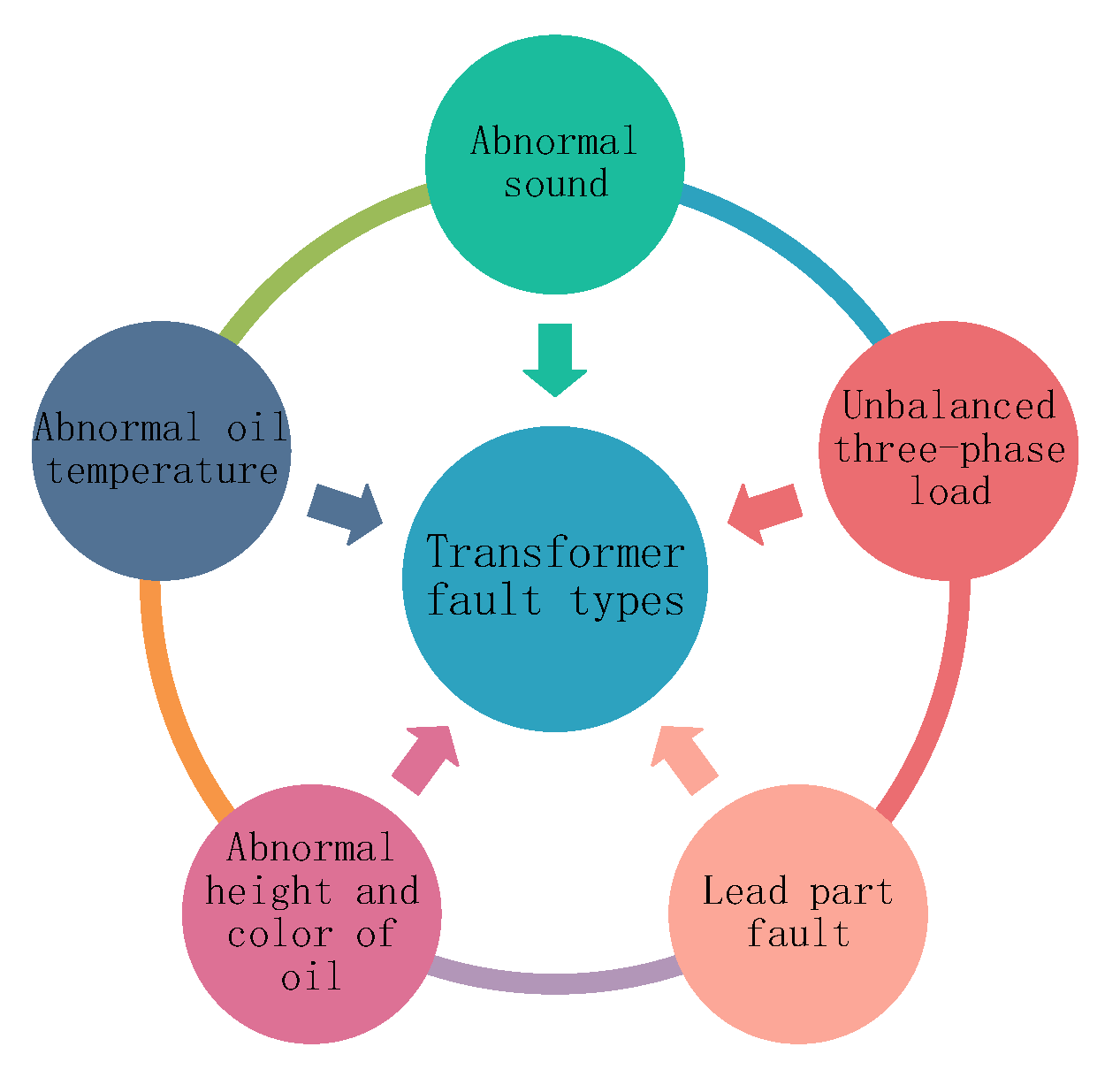
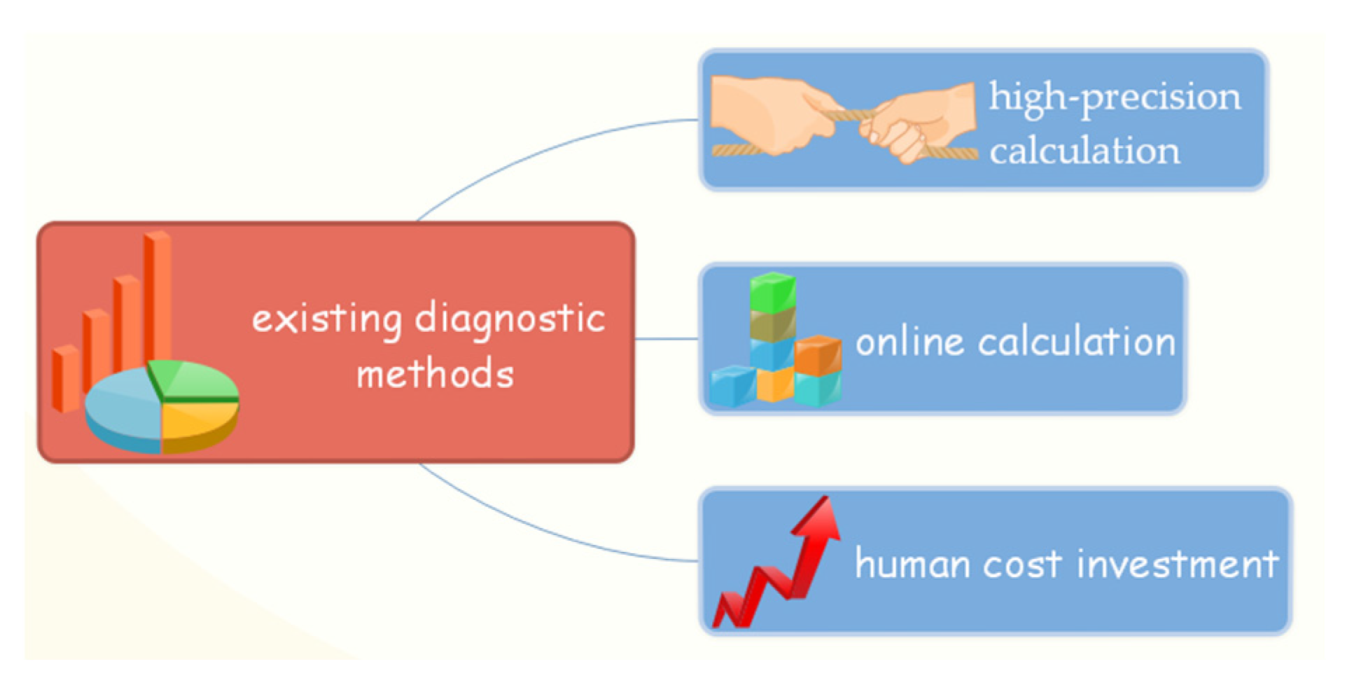

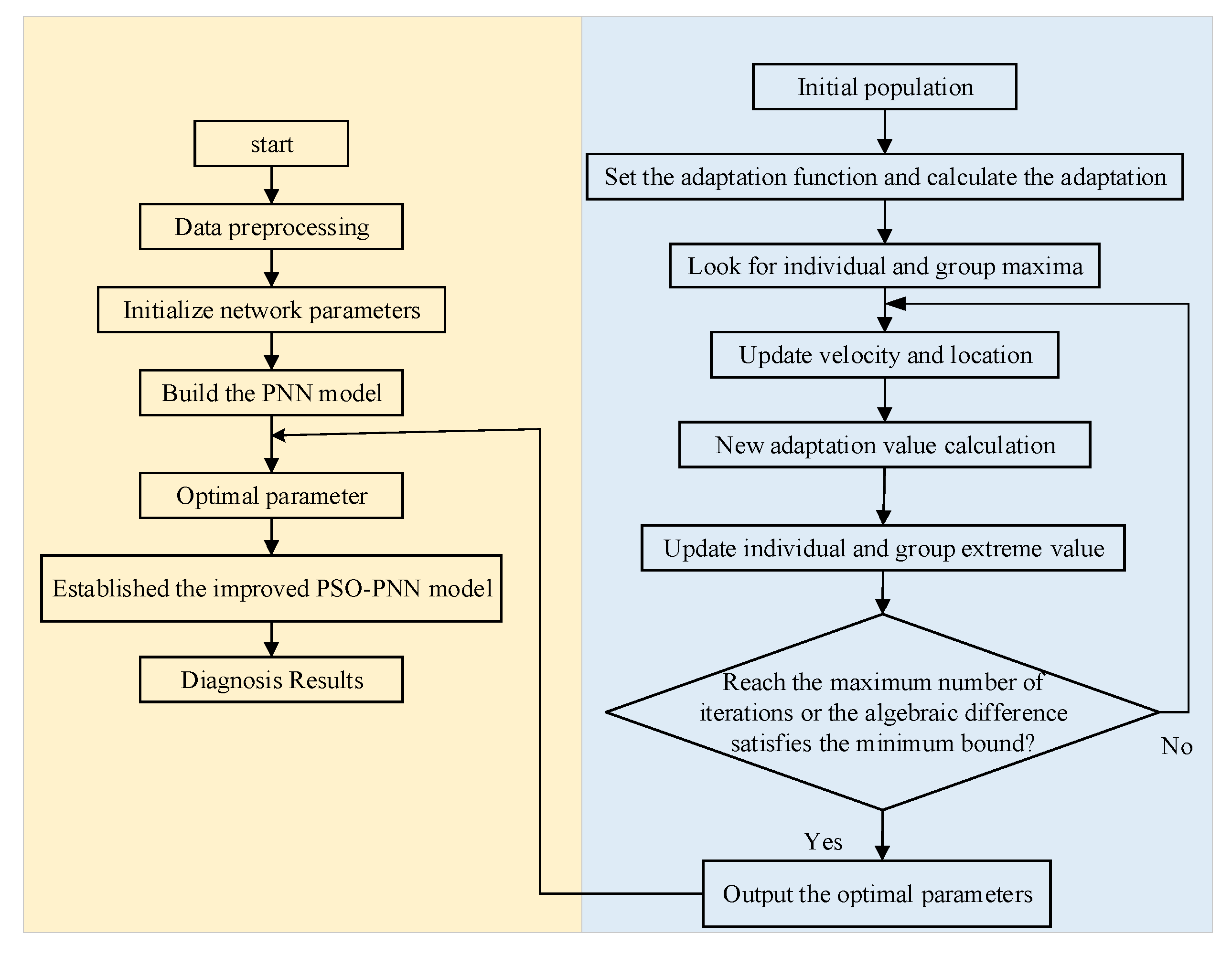
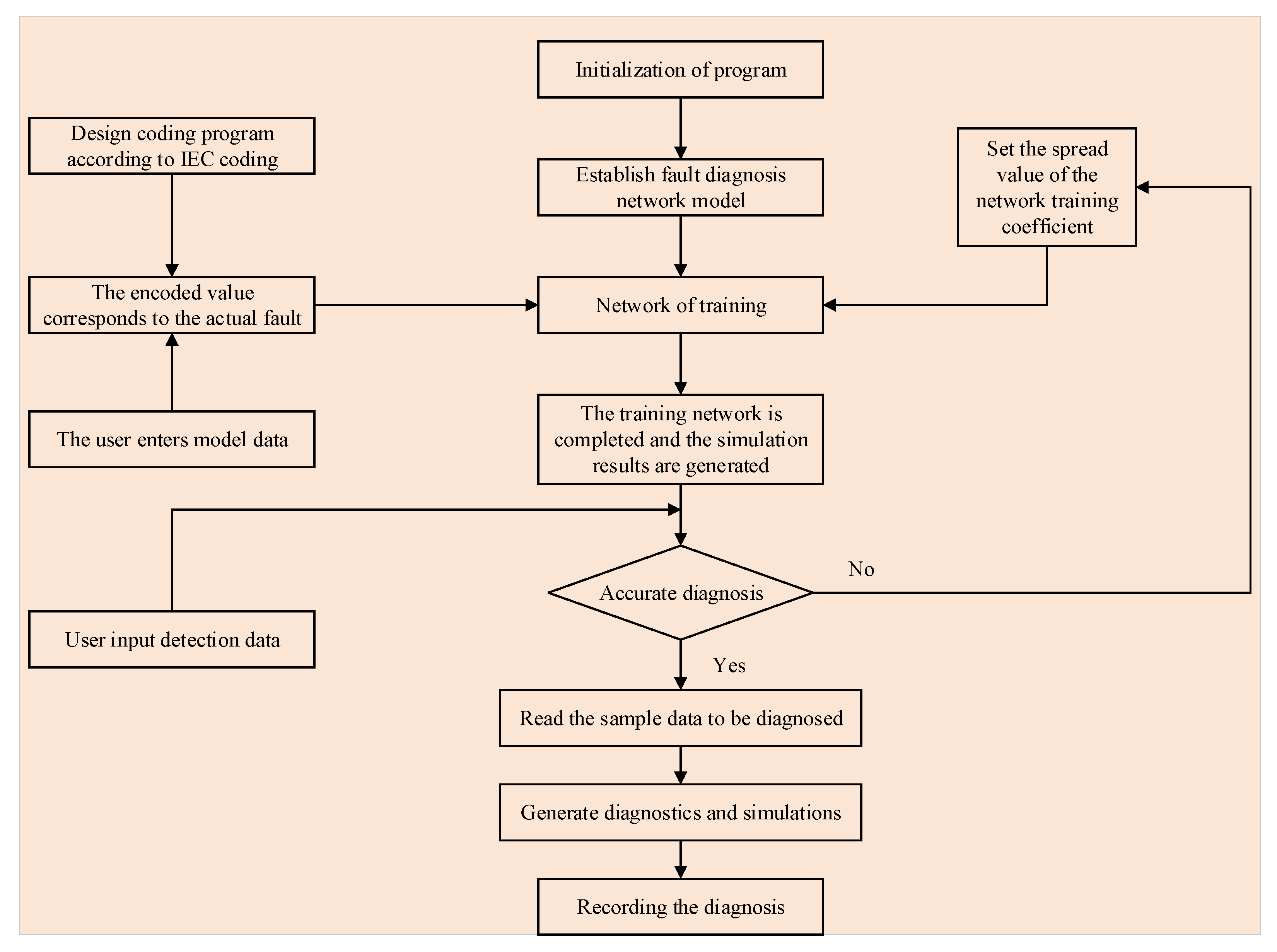
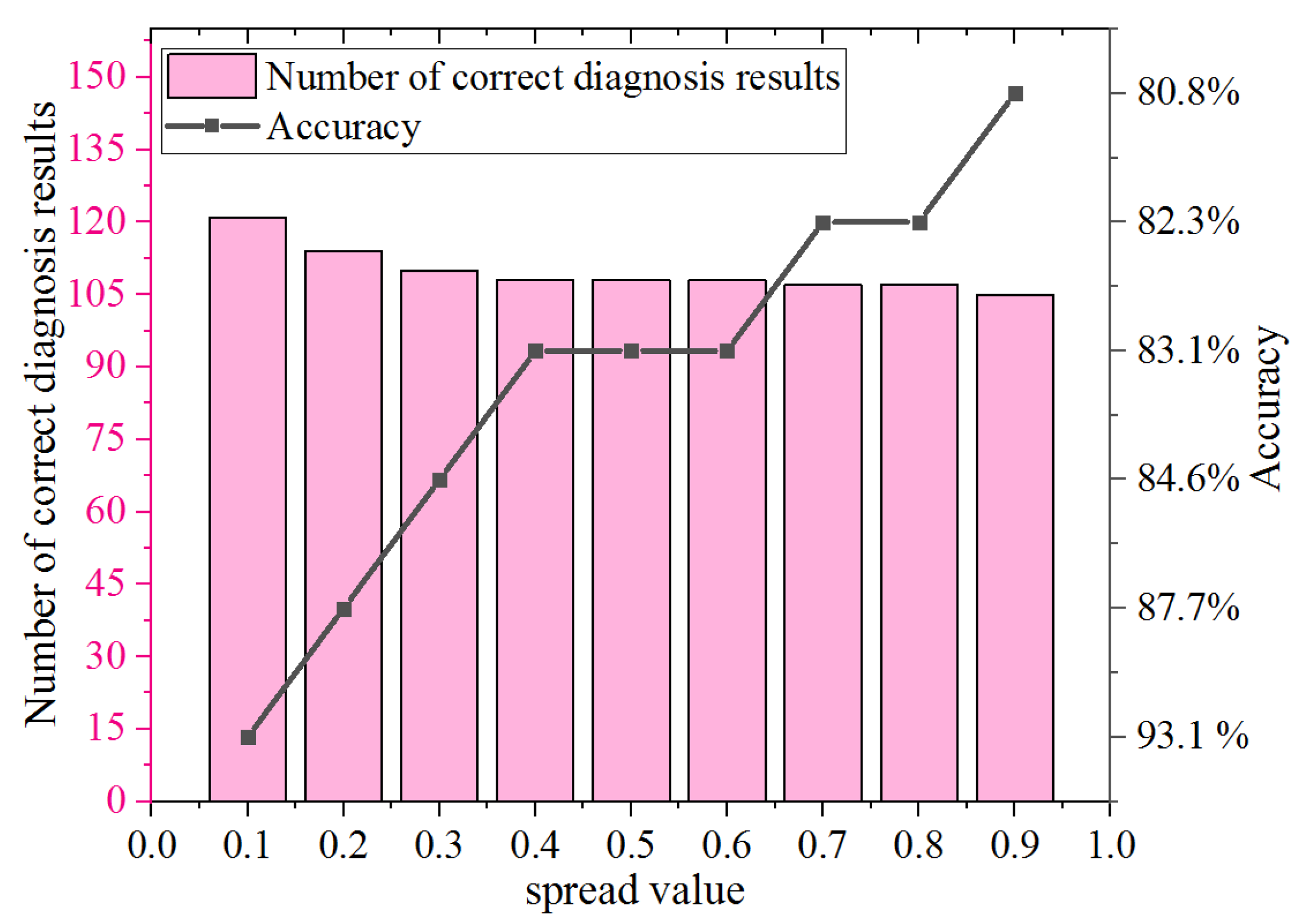

| Ratio Range of Dissolved Gas in Transformer | Coding Rules | ||
|---|---|---|---|
| C2H4/C2H6 | CH4/H2 | C2H2/C2H4 | |
| <0.1 | 0 | 1 | 0 |
| 0.1≤~<1 | 0 | 0 | 1 |
| 1≤~<3 | 1 | 2 | 1 |
| 3≤~ | 2 | 2 | 2 |
| Coding Combination | Types of Transformer Faults | ||
|---|---|---|---|
| C2H2/C2H4 | CH4/H2 | C2H4/C2H6 | |
| 0 | 1 | 0 | Partial discharge inside transformer |
| 0 | 1 | The oil temperature is overheated, and the temperature is below 150 °C | |
| 2 | 0 | The oil temperature is overheated, and the temperature is between 150 °C and 300 °C | |
| 2 | 1 | The oil temperature is overheated, and the temperature is between 300 °C and 700 °C | |
| 0, 1, 2 | 2 | The oil temperature is overheated, and the temperature is higher than 700 °C | |
| 1 | 0, 1 | 0, 1, 2 | Arc discharge |
| 2 | 0, 1, 2 | Arc discharge and high temperature | |
| 2 | 0, 1 | 0, 1, 2 | Spark discharge |
| 2 | 0, 1, 2 | Spark discharge and high temperature | |
| No. | Actual Fault Type | Diagnostic Results when the Sample Size Is 20 | Diagnostic Results when the Sample Size Is 20 | Diagnostic Results when the Sample Size Is 20 | Diagnostic Results when the Sample Size Is 20 |
|---|---|---|---|---|---|
| 1 | 4 | 4 | 4 | 4 | 4 |
| 2 | 2 | 2 | 2 | 2 | 2 |
| 3 | 9 | 3 | 9 | 9 | 9 |
| 4 | 7 | 5 | 5 | 5 | 7 |
| 5 | 4 | 4 | 4 | 4 | 4 |
| 6 | 3 | 2 | 3 | 3 | 4 |
| 7 | 5 | 5 | 5 | 5 | 5 |
| 8 | 4 | 7 | 7 | 4 | 4 |
| 9 | 1 | 2 | 1 | 1 | 1 |
| 10 | 6 | 6 | 6 | 6 | 6 |
| 11 | 4 | 4 | 4 | 4 | 4 |
| 12 | 7 | 4 | 7 | 7 | 7 |
| 13 | 5 | 5 | 5 | 5 | 5 |
| 14 | 8 | 2 | 2 | 3 | 8 |
| 15 | 3 | 2 | 3 | 3 | 3 |
| 16 | 5 | 3 | 5 | 5 | 5 |
| 17 | 4 | 2 | 3 | 3 | 3 |
| 18 | 2 | 2 | 2 | 2 | 2 |
| 19 | 4 | 4 | 4 | 4 | 4 |
| 20 | 7 | 2 | 2 | 2 | 2 |
| 21 | 7 | 5 | 7 | 4 | 7 |
| 22 | 2 | 2 | 2 | 2 | 2 |
| 23 | 3 | 2 | 2 | 1 | 1 |
| 24 | 7 | 4 | 4 | 7 | 7 |
| 25 | 5 | 4 | 5 | 5 | 5 |
| 26 | 7 | 7 | 7 | 7 | 7 |
| 27 | 3 | 2 | 2 | 3 | 3 |
| 28 | 4 | 2 | 2 | 2 | 3 |
| 29 | 1 | 1 | 1 | 1 | 1 |
| 30 | 3 | 3 | 3 | 3 | 3 |
| Number of correct diagnosis results | 13 | 21 | 23 | 26 | |
| Accuracy | 43.3% | 70% | 76.7% | 86.7% | |
| Number of Training Samples | The Proposed Method | Method in Literature [9] | Method in Literature [11] | |||
|---|---|---|---|---|---|---|
| Efficiency | Accuracy | Efficiency | Accuracy | Efficiency | Accuracy | |
| 30 | 24.6 s | 62% | 31.8 s | 54% | 41.7 s | 63% |
| 40 | 28.7 s | 67% | 35.7 s | 62% | 48.1 s | 65% |
| 50 | 32.1 s | 71% | 39.5 s | 66% | 55.9 s | 69% |
| 60 | 35.6 s | 73% | 45.6s | 70% | 62.4 s | 75% |
| 70 | 40.9 s | 78% | 51.7 s | 71% | 70.6 s | 77% |
| 80 | 46.5 s | 88% | 55.2 s | 75% | 75.4 s | 86% |
Disclaimer/Publisher’s Note: The statements, opinions and data contained in all publications are solely those of the individual author(s) and contributor(s) and not of MDPI and/or the editor(s). MDPI and/or the editor(s) disclaim responsibility for any injury to people or property resulting from any ideas, methods, instructions or products referred to in the content. |
© 2023 by the authors. Licensee MDPI, Basel, Switzerland. This article is an open access article distributed under the terms and conditions of the Creative Commons Attribution (CC BY) license (https://creativecommons.org/licenses/by/4.0/).
Share and Cite
Zhang, X.; Sun, Z. Application of Improved PNN in Transformer Fault Diagnosis. Processes 2023, 11, 474. https://doi.org/10.3390/pr11020474
Zhang X, Sun Z. Application of Improved PNN in Transformer Fault Diagnosis. Processes. 2023; 11(2):474. https://doi.org/10.3390/pr11020474
Chicago/Turabian StyleZhang, Xunyou, and Zuo Sun. 2023. "Application of Improved PNN in Transformer Fault Diagnosis" Processes 11, no. 2: 474. https://doi.org/10.3390/pr11020474
APA StyleZhang, X., & Sun, Z. (2023). Application of Improved PNN in Transformer Fault Diagnosis. Processes, 11(2), 474. https://doi.org/10.3390/pr11020474






